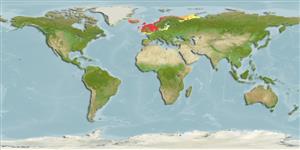Environment: milieu / climate zone / depth range / distribution range
Ekologi
marina; brackvatten bentopelagisk; djupintervall 10 - 150 m (Ref. 35388), usually 10 - 150 m (Ref. 35388). Temperate; 73°N - 49°N, 54°W - 60°E
Northeast Atlantic: 74°N (Novaya Zemlya and Bear Islands) to 49°N (Channel Islands, western English Channel), including eastern Greenland, Iceland, Barents Sea (but not the White Sea) and the Baltic (but not the Gulf of Bothnia and Finland).
Length at first maturity / Size / Vikt / Age
Maturity: Lm ?, range 11 - ? cm
Max length : 25.0 cm TL hane/ej könsbestämd; (Ref. 232); rapporterad maxålder: 10 år (Ref. 35388)
Short description
Morfologi | Morfometri
Taggstrålar i ryggfenan (totalt): 0; Mjukstrålar i ryggfenan (totalt): 56-63; Mjukstrålar i analfenan: 29 - 33. Scales absent from a median band anterior to the dorsal fin and from the musculature at the base of caudal fin. Belly scales loosely arranged, not in chevrons. Vertebrae 65-75. Margins of dorsal and anal fins straight with rays of equal length. Lateral line pores linearly arranged along the unbranched canals.
This schooling species is usually territorial and burrowing (Ref. 40). Feed on plankton. High activity is correlated to periods with strong tidal currents; then they leave their bottom hides and form large shoals. During low light intensity (night and winter) they bury in the bottom (Ref. 35388).
Muus, B.J. and J.G. Nielsen, 1999. Sea fish. Scandinavian Fishing Year Book, Hedehusene, Denmark. 340 p. (Ref. 35388)
IUCN Red List Status (Ref. 130435)
Threat to humans
Harmless
Human uses
Fiskeri: kommersiell
Verktyg
Special reports
Download XML
Internet-källor
Estimates based on models
Preferred temperature (Ref.
123201): 6.7 - 11, mean 9.7 °C (based on 1058 cells).
Phylogenetic diversity index (Ref.
82804): PD
50 = 0.5156 [Uniqueness, from 0.5 = low to 2.0 = high].
Bayesian length-weight: a=0.00275 (0.00205 - 0.00370), b=3.14 (3.07 - 3.21), in cm total length, based on LWR estimates for this species (Ref.
93245).
Trofisk nivå (Ref.
69278): 3.3 ±0.40 se; based on food items.
Resiliens (Ref.
120179): Mellan, lägsta populationsfördubblingstid 1,4-4,4 år (K=0.16-0.89; tm=1-3; tmax=10; Fec=4,000).
Fishing Vulnerability (Ref.
59153): Low to moderate vulnerability (30 of 100).
Nutrients (Ref.
124155): Calcium = 44.2 [24.8, 86.8] mg/100g; Iron = 0.34 [0.20, 0.60] mg/100g; Protein = 18.6 [17.2, 19.8] %; Omega3 = 0.448 [0.217, 0.891] g/100g; Selenium = 14.2 [5.9, 30.8] μg/100g; VitaminA = 36.1 [12.4, 109.0] μg/100g; Zinc = 0.825 [0.582, 1.152] mg/100g (wet weight);
